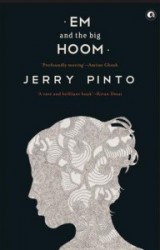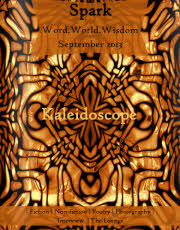by Priya Gopal
Very often, we tend to take the presence of our parents, siblings and friends in our lives for granted. This, despite knowing that Death stakes its claim on us someday. But what if life throws a different challenge at us?
‘Em and the Big Hoom’ tries to answer just this question. A touching and poignant semi- autobiographical novel by Jerry Pinto, the book deals with the loss that the unnamed narrator, his sister Susan and his father Augustine face when his mother, Imelda, turns suicidal and bipolar.
‘We snatched at her during the intervals’, reveals the anguish of a son who watched his mother oscillate from funny to caring, from daring to suicidal, from irreverent to melancholic as he was growing up. Em, as Imelda is known in the book, and as she is called by her children, is one of the protagonists of this book. The story tries to document her life through the eyes of her son, the narrator.
She begins her tryst with mental instability when the narrator is born and she inadvertently reminds him of it when she says, ‘“I don’t know ,Baba ,I don’t know why. It’s a tap somewhere .It opened when you were born.”
A son attempts to understand his mother – who she really is, before, during and after the spells of madness. As he traversers the path of life with her, we get varied glimpses into Em. Who is the Em that Augustine, his father (known as the Big Hoom) fell in love with, wooed, courted, married and remained with in joy and sorrow? The one who is delirious and happy and talks about anything from her sex life to her friendships or the one who repeatedly tries to commit suicide?
The story swings seamlessly between the present and the past and brings out the inherent pain of a little boy who grew up with a mentally unstable mother. As the book tries to reach into the pain and pleasures of Em and her family, you cannot miss the subtle humour that underlies the pain. Em’s ability to see things in a different perspective and usually with a tinge of sarcastic humour is the silver lining in the cloud.
Her attitude inspires us to live each day to the fullest. She smokes her beedis, doesn’t think twice before discussing her sex life with her own children and gives brilliant pieces of advice even when not asked for. Em loved to write. She wrote everywhere, in books, in letters she never posted, in little bits of paper, on any surface that could be written upon, but was never encouraged to be a writer. Societal attitudes towards the mentally ill that stopped even their loved ones from exploring anything different for them is a high point in the novel.
The narrator so frequently prays for a ‘whole mother, a complete family and with it the ability to turn and look away’. Praying for what we do not have is human and the emotions of a little boy, even inside a grown up man is heart-wrenching. For both the children, the mother is not a regular fixture in their lives. She wanders in and out of it. The point of narration where Em tells her children that she never wanted them as they turn a perfectly strong woman into a ‘muddha’ (mother!) is not only humorous but equally hard-hitting. She possibly brings out what every woman feels but never has the guts to say. Societal norms of motherhood ensure women keep mum about what they actually feel. But in her moments of madness, Em brings out many vital strands of truth that speak not just for herself but for so many others.
Em and her children are held together by the Big Hoom. His place in their lives is very special. An anchor to this chaotic ship that he captains, his children adore him while Em loves him truly. The Big Hoom is an important part of Em’s life. Their relationship begins as an office romance where he flirts around with the secretary who later on goes ahead to become his life partner. Hoom is not just Em’s husband, but her soul mate. She may tease him and taunt him, but she adores him and values his presence in her life.
Susan, the narrator’s sister is in an equally passionate relationship with her mother. She is however, the more pragmatic of the two siblings. She provides the necessary emotional support for the narrator time and again by bringing a very practical perspective to many a situation. She is able to see her mother and the condition that she suffers from as two entities. Susan consoles her crying brother with ‘that’s not her, it’s her problem.’
The ability to see beauty in the mundane is something Em teaches all through this novel. She calls ‘The Big Hoom’ ‘angel ears’ as she feels they look like pieces of fried bacon! She teaches Susan and the narrator to differentiate a person from the personality. How often do we look beyond the personality and figure out why the person does what she or she is doing?
The tumultuous journey through the lives of four people cooped in a Mahim chawl in Mumbai is a rollercoaster ride. The book navigates through the dark crowded parts of Em’s mind and while trying to dust the cobwebs in there, turns around and asks very unsettling questions. It makes us look at a ‘mad’ person with a whole new perspective.
Who is mad? Em? Or the rest of the world?
Who needs help? Em? Or the family?
The novel questions societal norms. It makes you take another look at your perceptions about people who are not like us. With minimal melodrama in it, the story ambles away like a river only to suddenly gurgle and rush into a waterfall, roaring and kicking and then settling into a calm that may just be waiting for another turn.
The book pulls heartstrings in a very beautiful way. It compels you to get back to it over and over again just to see if you missed anything beautiful and trust me when I say that each time I read it, I feel differently about it. It brings in emotions that range from joy at Em’s victories to indulgence at her idiosyncrasies to sorrow and pain at her suffering. At no point, however, does it want you to pity Em or her family. It inspires to celebrate every moment of your life. It inspires you to reach within yourself. Em connects you to your true self.
Priya Gopal is the Section Head (CBSE) at the Curriculum Department of Kangaroo Kids Education Ltd., Mumbai. An educator by choice, teaching and interacting with kids is something that has enthused her over the last 16 years. Priya lives in Mumbai with her husband and two children. She blogs at http://keepsmilinginlife.blogspot.com







Every once in a while a book comes out that touches you so profoundly, that you remain silent for a very long time after turning the last page of the book. This is one of those. This small and delicately written story of a mentally ill mother’s relationship with her kids and her husband, speaks more than its pages reveal. Whats left unsaid, is equally heart wrenching. Jerry Pinto has really hit the nail with this story, his first. Not many could have finished it without having to cope with tears, at least from inside. Family bonding at its best. Jerry sir, Hats off! Em is a character that is going to come in my dreams more regularly than harry potter ever did.
Priya, just one word – “beautiful”.
You have brought out very succinctly the essence of the entire story and that too very sweetly – admirable.
The review compels its reader to snatch the earliest copy and read the book!
I was reminded of the role of Vivien Leigh in the Hollywood movie “A Streetcar named Desire”
Keep it up!
Simply marvellous.
well done priya…
Beautiful book and equally good review. May i say, Like father Like daughter. I can understand agony of the children. One of my good friends whose mother had died in his early childhood was the only child of his unbalanced (lunatic) father. Children in the locality used to throw stones at him and the child had to bring back the father.
R.P. Donde